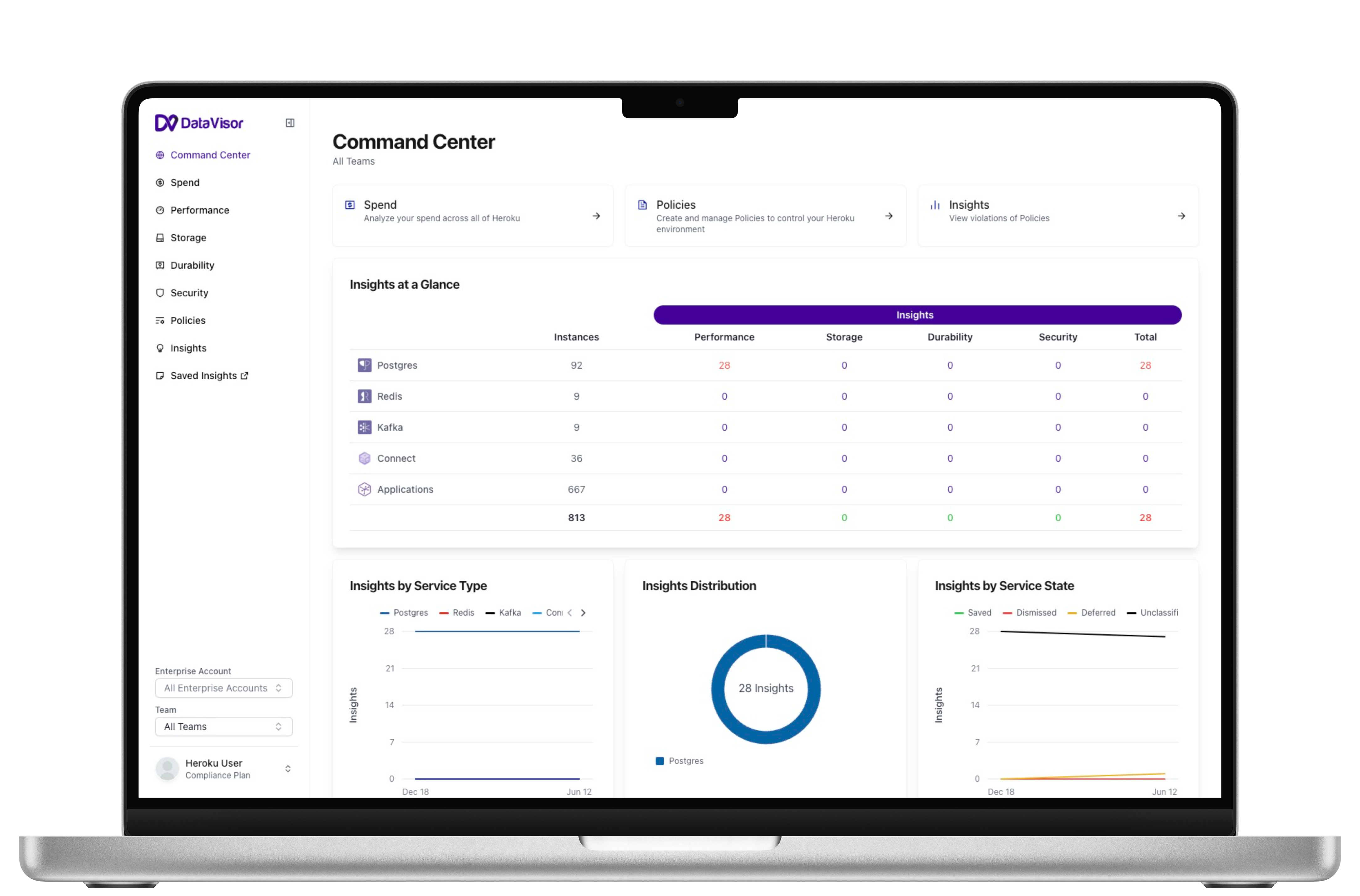This add-on is operated by Raiquun
Intelligently manage and optimize your Applications and Data Services
DataVisor by Raiquun
Last updated June 18, 2025
This is a draft article - the text and URL may change in the future. This article is unlisted. Only contributors can access it.
The DataVisor by Raiquun add-on is currently in beta.
Table of Contents
DataVisor by Raiquun enables you to intelligently manage and optimize your organization’s Applications and Data Services in one place. With DataVisor, your organization can control and right-size its ever-changing Heroku environment.
DataVisor actively monitors your:
- Application dynos
- Heroku Postgres databases with support for Heroku Connect
- Heroku Key-Value Store instances
- Apache Kafka on Heroku clusters
Provisioning the Add-on
DataVisor monitors all of your organization’s Applications and Data Services, regardless of which app you attach it to. Therefore, you only need to add DataVisor to one of your organization’s apps. We recommend adding DataVisor to an app that perpetually exists in your organization’s account, such as an app specifically dedicated to DataVisor.
Reference the DataVisor Elements Page for a list of available plans and regions.
Using the Heroku Elements Marketplace
Click Install DataVisor by Raiquun on the DataVisor Elements Page.
Using the Heroku CLI
Attach DataVisor to a Heroku application via the CLI:
$ heroku addons:create raiquun:<plan> --app <app>
See the Managing Add-ons dev center article for more CLI installation instructions.
DataVisor Dashboard

DataVisor provides an interface to view and interact with your organization’s Heroku environment via its dashboard. Access the DataVisor dashboard by clicking the DataVisor by Raiquun add-on in your app from the Heroku Dashboard, or with the heroku addons:open raiquun command.
DataVisor provides a detailed, intelligent view of the telemetry of your organization’s Applications and Data Services on the Spend, Performance, Storage, Durability, and Security pages of the dashboard.
DataVisor actively monitors your organization’s Heroku environment via Policies and Rules you create, and Insights generated from those Policies. Policies are a set of Rules, created on a Service type basis. You can apply Policies to one or all of the Services within that Service type. Rules are metric thresholds that when triggered, create Insights surfaced in the UI throughout the dashboard.
The dashboard provides these pages:
- Policies: create, view, update, and delete Policies and Rules
- Insights: view and take action on Insights
- Saved Insights: view and share Insights your organization has saved
Migrating Between Plans
Using the Heroku Dashboard
To migrate to a new plan through the dashboard:
- Click the app with DataVisor installed in the Heroku Dashboard.
- Find DataVisor by Raiquun in the
Add-onssection of theResourcestab on the app’s dashboard. - Click
Actionson the add-on listing, and then clickModify Plan.
Using the Heroku CLI
Through the CLI, use the heroku addons:upgrade command to migrate to a new plan:
$ heroku addons:upgrade raiquun:<upgraded or downgraded plan>
Removing the Add-on
Remove DataVisor via the CLI:
This action destroys all associated data and you can’t undo it! To request a copy of your data, email support@raiquun.com.
$ heroku addons:destroy raiquun
Support
Submit all DataVisor support and runtime issues via one of the Heroku Support channels. If you’re experiencing issues with the DataVisor dashboard or have product feedback to share, contact our support team at support@raiquun.com.